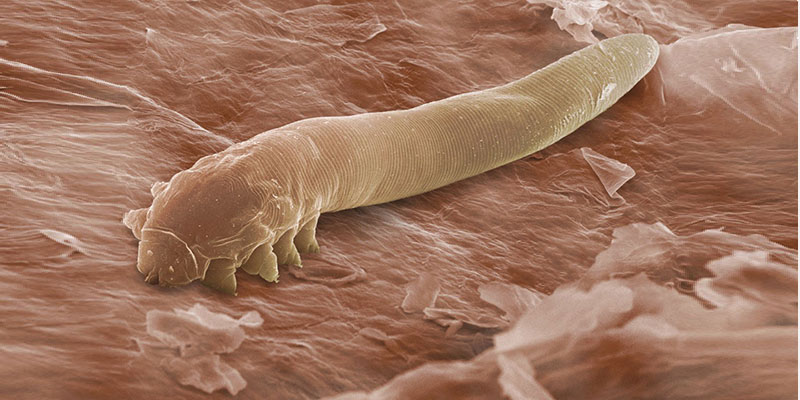Demodex in humans are different from the ones in animals.
The Demodex mite is a tiny arachnid (8 legged) parasite that infects human skin and causes issues. They are related to dermatitis, rosacea, and blepharitis (as well as other skin diseases). At least some mites live on every person.
These microscopic creatures live on almost every human’s face. They feed on the oils of the sebaceous glands and around the hair roots and creating infections in the skin.
They also lay their eggs in burrows that they have tunneled into your skin, which encourages bacteria and contamination. They further damage the skin through their own excretion of waste. And they die and then decompose inside the skin’s layers.
For the vast majority of people, there are no discernible side effects from having either D. folliculorum, which resides in pores and hair follicles or D. brevis, which lives inside the sebaceous glands. (Source)
How Is Demodex Related to Skin Disease?

For the majority of people, there will never be an issue because of these mites.
However, in cases with an abnormal infestation accompanying a compromised immune system or an allergy, the skin can have a significant reaction with major inflammation and what is sometimes mistaken for acne. The skin around your eyes can also become irritated and red. And your lashes can develop a scaly look or become crusty. This is when Demodex is an issue. A proper treatment will stop the inflammation. It will stop symptoms such as the widening of pores, damaged capillaries and blood vessels, and other visible signs of unhealthy skin. This destruction of the skin will continue over time if left untreated.
Much of the irritation comes from population explosions of mites, or rather when those populations die.
It turns out that the waste products of the mites are expelled all at once upon death. This flush of bacteria is linked to rosacea and other skin ailments. While the mites subsist within the hair follicles of human eyelashes, there may develop an inflammation called blepharitis, which can become quite serious. Since the mite populations increase as humans age, the chances of these types of outbreaks are also higher with age. It is also when our eyes are most at risk of losing some of their functionality. Since 44% of those with blepharitis have Demodex and virtually 100% of the population over 70 carries a significant load of mites, it is important for everyone, but especially for seniors, to be diligent in their approach toward and treatment of these tiny animals.
How Did I Get Mites?

Demodex is in fact contagious in that mites can move from one host to others. This happens either by the animal itself physically crawling to another person, or by eggs, which are carried on dust, being blown to a new host. Scientists presume that babies pick up mites from their mothers and that throughout our lives we encounter an enormous number of opportunities for new mites to be introduced to our skin. Mites show no gender preference and despite the increase in population as people age, there is not so much an age preference by the tiny animals as there is a natural, not a transient, population cycle that demonstrates dramatic growth over a human life-span.
Can I Get Rid of My Mites?

It is the life-cycle of the mite itself that gives the best clues of how to treat Demodex in humans. The Demodex mite only lives for 2 to 2 ½ weeks after hatching from its egg. During its brief life, it moves from a larval stage to a protonymph to deutonymph and then adult. The mite population growth is dependent on the host skin’s features acting as an ecosystem.
Reproduction occurs when mature male and female mites meet in a hair follicle. They copulate and then the female successfully deposits eggs in the sebaceous gland. The eggs hatch into larvae, beginning a new generational life cycle. Both species of mite live on human skin. Both are cohabitating on the eyes, nose, and in the ears or other parts of the face. Understanding that mites primarily subsist on sebum and that they do not live long without a host are critical pieces of information when looking at how to treat Demodex. (Source).
The most effective way to treat Demodex in humans is to take comprehensive action. Thereby it will eliminate the eye and skin irritations that come with an infestation of Demodex mites. This requires the killing of the adult mites, stopping the immature mites and eggs from becoming sexually reproducing adults, and preventing more mites from infecting the skin.
Tea tree oil is a remarkably effective miticide, but if used in too heavy a concentration it can cause significant skin irritation. For treating the extra sensitive areas around the eye, Cliradex Towelettes can do the trick with the most important ingredient from tea tree oil adjusted for the best effect without irritation.
And while it is essential to treat Demodex before the symptoms are unbearable, every person has mites and it is impossible to completely keep them off of your skin. What you are aiming for is the management of infestations. Regular use of a product like Cliradex will be your best tool in this effort.




